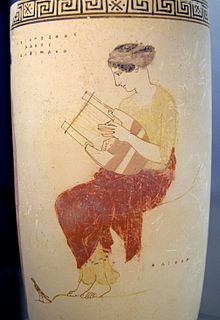Kithara


The kithara ancient Greek κιθάρα is a stringed instrument from ancient Greece . It was one of the most distinguished instruments, which was preferably played on solemn occasions, especially during the cult in honor of the god Apollo . Despite a similarity between the two lyres , the lyre and kithara were different instruments. The lyre was mostly smaller and had no foot.
The German names for the guitar and the zither are derived from the Greek word κιθάρα kithara . In Greek today κιθάρα denotes both the ancient instrument and the guitar.
history
The kithara was a five to twelve string instrument and developed in the 8th / 7th. Century BC From the mostly four- stringed Phorminx ( φόρμιγξ ). The epic poet Homer called playing with the Phorminx kitharis or kitharizein . Both instruments were dedicated to the god Apollon . He plays the kithara in a music contest with Pan .
In the early translations of the Old Testament , the Greek kithara was used to render the Hebrew word kinnor for the old biblical lyre.
mythology
In Greek mythology, the kithara was invented by Hermes. On the day he was born, he got out of his cradle and met a sea turtle outside his cave. Being interested in the shell, he killed the turtle and tore out the meat. When he noticed that the shell sounded hollow, he found a cattle and killed it. He stretched the cattle's intestines over the shell. Thus the kithara was invented. Hermes later gave this to Apollo to make him forgive about the killing of his cattle.
Design
The centerpiece was a sound box made of wood. At the front it was flat, at the back it was arched (after depictions of coins and sculptures), and at the bottom it was straight. The side of the left body of sound in two mutually bent, a Oval on forming (hollow) arms which expired in parallel ends. The instrument thus had a certain resemblance to a large, inverted Omega ( Ω ). A cross bar (yoke) connected the parallel ends of the arms and served as a string tensioner. From there the strings ran in a V-shape over the sound box and a guide bar to the tailpiece at the lower end of the instrument. The kithara with a large body that is straight at the bottom was played by professional male musicians. There was also a so-called cradle kithara with a round body on the underside.
Style of play
The kitharistes ( κιθαριστής ), the kithara player, usually held the instrument vertically in front of him in a standing position by fixing it to his chest with a strap running over his left wrist. The right hand plucked strings with a plectrum (impact flakes of metal , ivory and wood). The left hand dampened the string or gave the string higher fundamental vibrations by shortening it. In some (later) forms, the instrument was held with a shoulder strap. The cradle kithara was mostly played by women ( kitharistai ) as muses and hetaera without singing.
A kitharodos ( kitharodos ) accompanied his self-composed verses on a kithara.
literature
- Martin L. West: Ancient Greek Music. Clarendon, Oxford 1992, 2005, ISBN 0-19-814975-1 .
- John G. Landels: Music in Ancient Greece and Rome. Routledge, London 1999, 2002, ISBN 0-415-24843-4 .
- Stefan Hagel, Christine Harrauer (Eds.): Ancient Greek Music in Performance. Vienna 2003, 2005, ISBN 3-7001-3475-4 .
